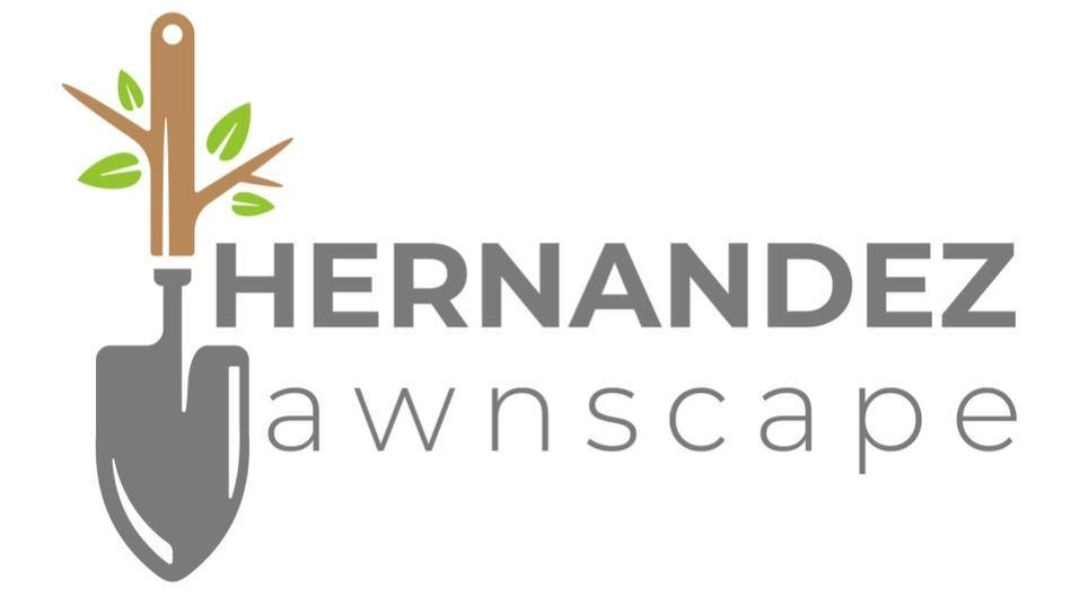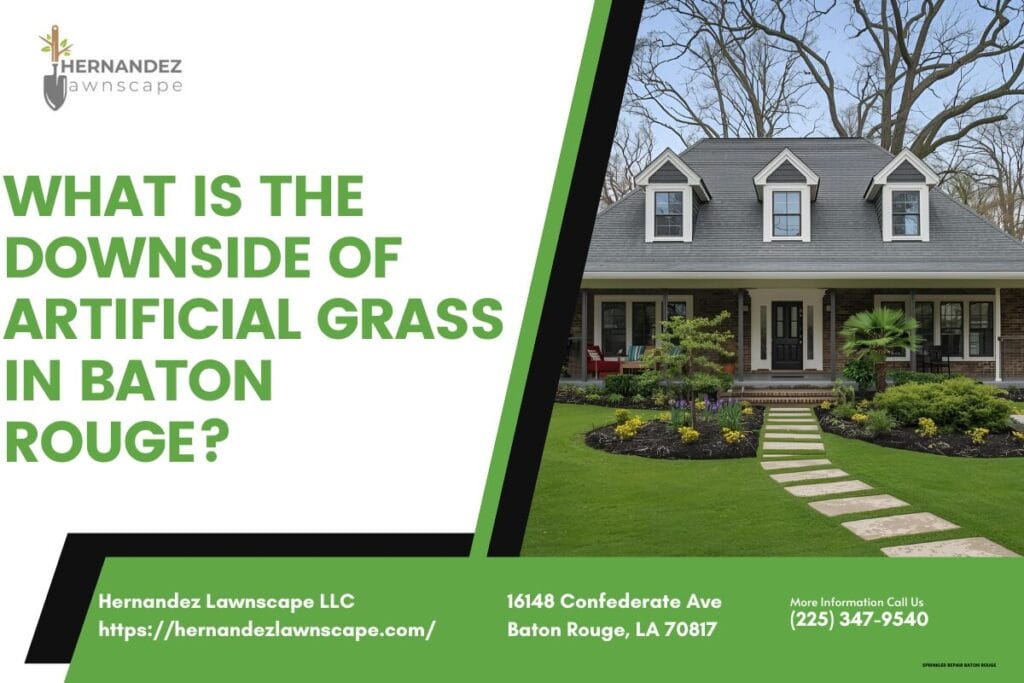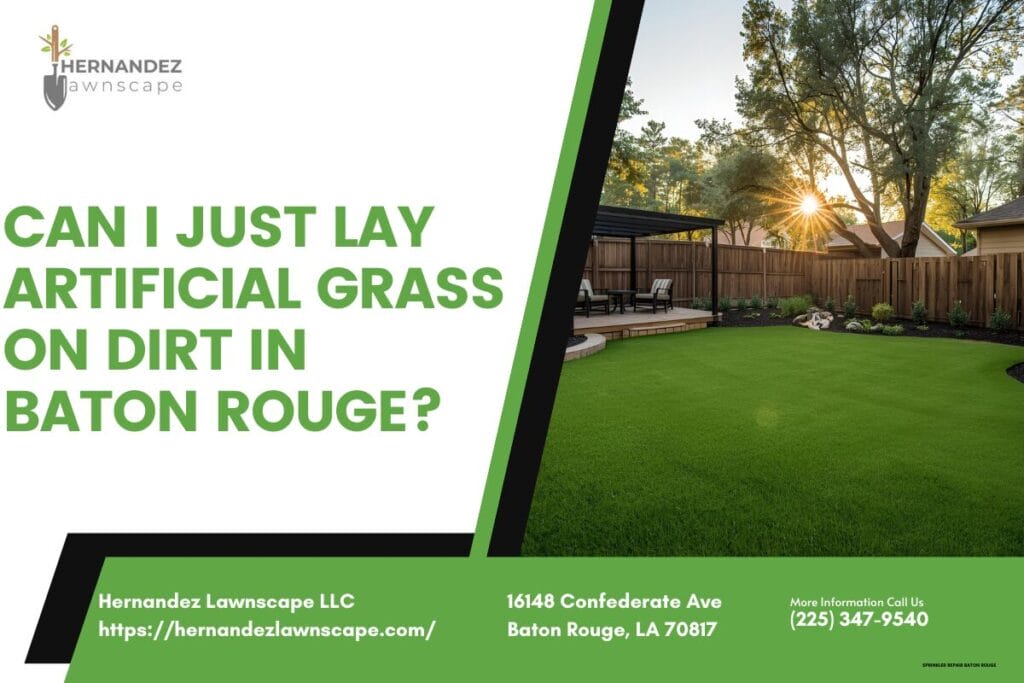Beyond general concerns, artificial turf poses a uniquely amplified threat in Baton Rouge, where the region’s intense heat and heavy rainfall transform its known flaws—extreme surface temperatures and toxic chemical runoff—into critical liabilities for local property, health, and the fragile Louisiana ecosystem. Understanding these specific, climate-driven problems is essential before making a significant investment in a synthetic lawn.
As a team of dedicated landscape professionals at Hernandez Lawnscape with years of hands-on experience across East Baton Rouge Parish, we’ve seen the allure of a “maintenance-free” lawn. The promise of a perpetually green yard with no mowing is a powerful one, especially during our long, hot summers. However, we believe in empowering our clients with the full picture. The truth about low-maintenance turf is more complex than the sales pitch suggests, and the problems with synthetic turf in the Baton Rouge climate are significant and often overlooked.
This guide moves beyond the generic pros and cons of artificial grass to provide a Baton Rouge-specific analysis. We will examine the real-world impact of our local weather on these plastic products and explore the hidden costs and risks they bring to our community.
The ‘Baton Rouge Burn’: A Searing Reality of Synthetic Turf
One of the most immediate and dangerous disadvantages of artificial grass in Louisiana is its capacity to absorb and retain heat. While a natural grass lawn uses a process called transpiration to cool itself and the surrounding air, a synthetic lawn, made of plastic and rubber, acts like an asphalt parking lot. This creates a significant urban heat island effect right in your own yard.
In a city like Baton Rouge, where summer temperatures regularly climb into the high 90s with stifling humidity, the surface of an artificial lawn can become dangerously hot. Research has shown that on a 90-degree day, the temperature of artificial turf can reach 150 degrees or higher, which is hot enough to burn skin according to recent reports. This isn’t just uncomfortable; it’s a serious health risk.
For families, this effectively renders your backyard unusable for large parts of the day. The question of how hot does fake grass get in a Louisiana summer is answered with “too hot for comfort or safety.” Children can suffer burns from even brief contact, and the downside of fake grass for dogs is even more acute. Pets can easily burn their paws and are more susceptible to heatstroke on these superheated surfaces. This raises serious artificial turf health risks for children and pets that simply don’t exist with natural grass.
Exacerbating Flood Risk in a Water-Logged City
Baton Rouge is no stranger to heavy rainfall and drainage challenges. From afternoon thunderstorms to the deluges of hurricane season, managing stormwater is a constant concern for homeowners from the Garden District to Shenandoah. Unfortunately, most artificial turf installations make this problem worse.
A natural lawn is a porous, living system. Soil, roots, and microorganisms absorb a significant amount of rainwater, filtering it and allowing it to recharge the groundwater. A synthetic lawn, in contrast, is largely impervious. The plastic sheeting and compacted base required for installation prevent water from soaking into the ground. While some systems incorporate drainage, their capacity is often overwhelmed by the sheer volume of water we receive in a typical Louisiana downpour.
This leads to increased water runoff contamination from plastic lawns. Instead of being absorbed, rainwater sheets off the surface, carrying with it any surface debris, chemicals, and microplastics. This intensifies the burden on municipal storm drains, which can contribute to localized flooding on your property and in your neighborhood. We’ve seen firsthand how poor drainage issues with artificial grass in heavy rain can lead to water pooling against a home’s foundation or flooding adjacent patios. Fixing drainage problems under synthetic turf is a costly and disruptive repair, one of the many hidden costs of installing an artificial lawn.
Leaching a ‘Toxic Gumbo’ into Our Soil and Waterways
Perhaps the most alarming environmental impact of artificial lawns in Baton Rouge is the chemical cocktail they release into our environment. The materials used in synthetic turf—from the plastic blades to the crumb rubber infill—are not inert. They contain a host of chemicals that can be harmful to human health and the ecosystem.
Scientific studies have confirmed that chemicals identified in artificial turf include polycyclic aromatic hydrocarbons (PAHs), phthalates, and per- and polyfluoroalkyl substances (PFAS), which are known carcinogens, neurotoxicants, and endocrine disruptors according to the National Institutes of Health. In fact, many types of artificial turf contain PFAS, known as ‘forever chemicals’ because they accumulate in the environment and living tissue and do not break down naturally.
In our rainy climate, this presents a direct threat. Each downpour washes over the turf, leaching these toxins and carrying them into our storm drains, which empty into local waterways like Bayou Fountain and the Amite River. Studies have found that contaminants harmful to aquatic life, such as zinc, have been found in stormwater runoff from artificial turf fields according to environmental reports. Another chemical derived from car tires, 6-PPD quinone, which can be present in turf infill, was found to be lethal to coho salmon, demonstrating a direct threat to aquatic ecosystems in scientific testing.
The negative impact of synthetic lawns on soil health is also profound. The soil underneath is starved of oxygen and organic matter, effectively killing the living ecosystem beneath the plastic blanket. This makes it incredibly difficult to ever return the area to a natural state.
The Landfill Legacy: A Permanent Plastic Problem
While often marketed as a permanent solution, artificial grass has a finite lifespan. What happens to artificial grass after 10 years? Subjected to the intense Louisiana sun and high humidity, the materials degrade. Does artificial turf fade or melt in Louisiana sun? Yes, UV radiation breaks down the plastics, causing them to become brittle, faded, and flattened. The lifespan of artificial grass in the southern US is typically shorter than in milder climates, often lasting only 8 to 15 years.
When it reaches the end of its life, disposal becomes a major issue. Artificial turf is a composite product made of multiple types of plastic and rubber that cannot be easily separated for recycling. As a result, there are virtually no effective options for recycling old artificial turf in East Baton Rouge Parish. This means every synthetic lawn installed today is destined for a landfill. Research confirms that artificial turf has a lifespan of eight to 10 years, after which it is typically disposed of in a landfill, contributing to solid waste pollution as a major source of plastic waste.
This creates a long-term environmental burden. Your “green” lawn becomes a permanent piece of plastic waste, contributing to microplastic pollution as it breaks down over hundreds of years. This is a significant factor to consider for any eco-conscious homeowner.
Key Decision Factors: Artificial Turf vs. Natural Grass in Baton Rouge
To make a confident decision, it’s helpful to directly compare the options based on the factors that matter most to local homeowners. Here’s a breakdown comparing artificial turf vs sod in Baton Rouge across critical areas.
Health and Safety Risks
Artificial Turf: High risk. Surfaces can reach burn-level temperatures (150°F+), posing a danger to children and pets. The plastic blades can be abrasive and cause skin burns from friction. Constant exposure to leached chemicals like PFAS and PAHs is a primary health concern, especially for children who play on the surface.
Natural Grass: Low risk. A natural lawn is significantly cooler, often 30-40 degrees cooler than artificial turf on a hot day. It provides a soft, non-abrasive surface for play. It poses no chemical leaching risk; instead, it filters pollutants from the air and water.
Environmental Impact
Artificial Turf: Negative impact. It contributes to the urban heat island effect, increases stormwater runoff and flooding risk, and leaches toxic chemicals and microplastics into local waterways. It destroys soil biodiversity and ends its life as non-recyclable landfill waste. Ecotoxicology studies on invertebrates exposed to crumb rubber (a common turf component) have identified risks to organisms whose habitats have been contaminated by artificial turf runoff according to research on ecosystem health.
Natural Grass: Positive impact. It actively cools the environment, absorbs rainwater to mitigate flooding, filters pollutants, produces oxygen, and supports a healthy soil ecosystem for insects and microbes, which in turn supports local biodiversity.
Property Management and Long-Term Costs
Artificial Turf: High long-term costs. While initial marketing focuses on low maintenance, the reality is different. It requires regular cleaning, disinfecting (especially with pets), and infill material replenishment. Repairing seams and edges can be complex. The eventual replacement cost after 8-15 years is substantial, representing a major financial downside. Pet odor problems with artificial turf are a common complaint and can be very difficult to eliminate. There are also potential negative effects on property value, as many buyers see it as a liability to be removed.
Natural Grass: Manageable ongoing costs. Requires regular mowing, watering, and occasional fertilization. These long-term maintenance costs of fake grass are often underestimated in comparison. A healthy, well-maintained natural lawn is consistently seen as an asset that boosts curb appeal and property value.
Making the Right Choice for Your Needs
The best lawn is one that fits your lifestyle, budget, and values. As a Baton Rouge landscaper, our goal is not to make the decision for you, but to provide the local context needed to make a wise one. “They always go a step beyond what I expect and consistently provide excellent service,” is feedback we cherish, and it comes from this commitment to honest guidance.
For the Health-Conscious Parent:
If your primary concern is creating a safe play space for your children, the extreme surface temperatures and the documented leaching of carcinogens and endocrine disruptors from synthetic turf are critical red flags. A natural grass lawn provides a cooler, softer, and non-toxic surface where kids can play without the risk of burns or chemical exposure.
For the Eco-Conscious Homeowner:
If minimizing your environmental footprint is a priority, artificial grass presents a significant conflict. Its reliance on fossil fuels for production, its negative impact on local water quality through toxic runoff, its contribution to microplastic pollution, and its ultimate destination in a Louisiana landfill are all major environmental liabilities. Alternatives to artificial grass in Baton Rouge, like native groundcovers or a well-managed natural lawn, are far more sustainable choices that support the local ecosystem.
For the Commercial Property Manager:
For a business or multi-family property, the long-term liability of artificial turf should be carefully weighed. The heat island effect can increase cooling costs for surrounding buildings. The risk of burns creates a potential safety liability. Furthermore, the high cost of replacement every 10-15 years, coupled with the potential for costly drainage repairs, makes the total cost of ownership much higher than it initially appears. A professionally managed natural landscape often proves to be a more sustainable and financially sound long-term investment.
We’ve helped countless homeowners navigate these decisions, and a common theme among those who chose differently is the regret of homeowners with artificial grass when faced with the realities of our climate. “I could not be more pleased with Hernandez Lawnscape. Excellent service all around…5 stars!” This kind of satisfaction comes from making an informed choice that truly works for the long haul in Baton Rouge.
Ultimately, the conversation around lawns in South Louisiana must account for our unique environment. The downsides of artificial grass are not just theoretical here; they are practical, daily challenges driven by our intense sun and torrential rain. Before you invest in a plastic lawn, consider the heat, the water, the toxins, and the waste it will leave behind.
Choosing the right landscape for your property is a major decision. For a personalized assessment of your yard’s specific needs and a transparent discussion about the most sustainable and beautiful options for our Baton Rouge climate, contact the expert team at Hernandez Lawnscape today. We’re here to help you create a landscape you can be proud of for years to come.




